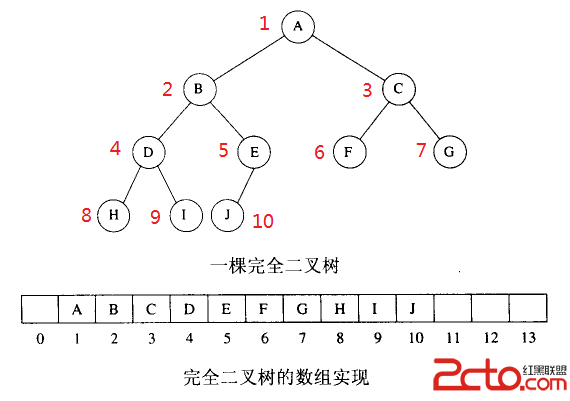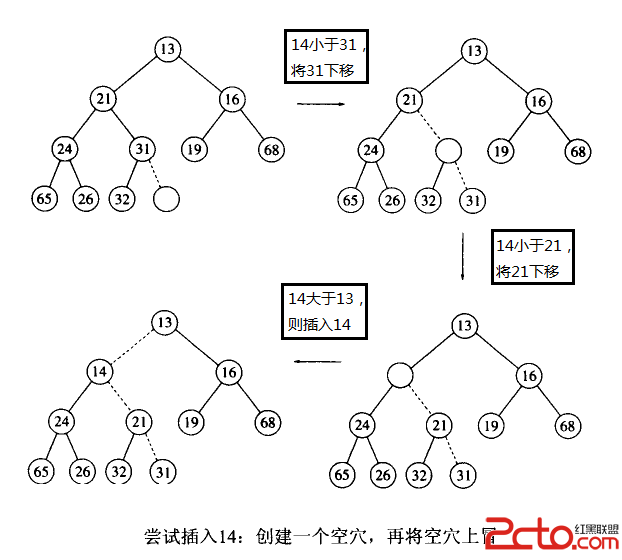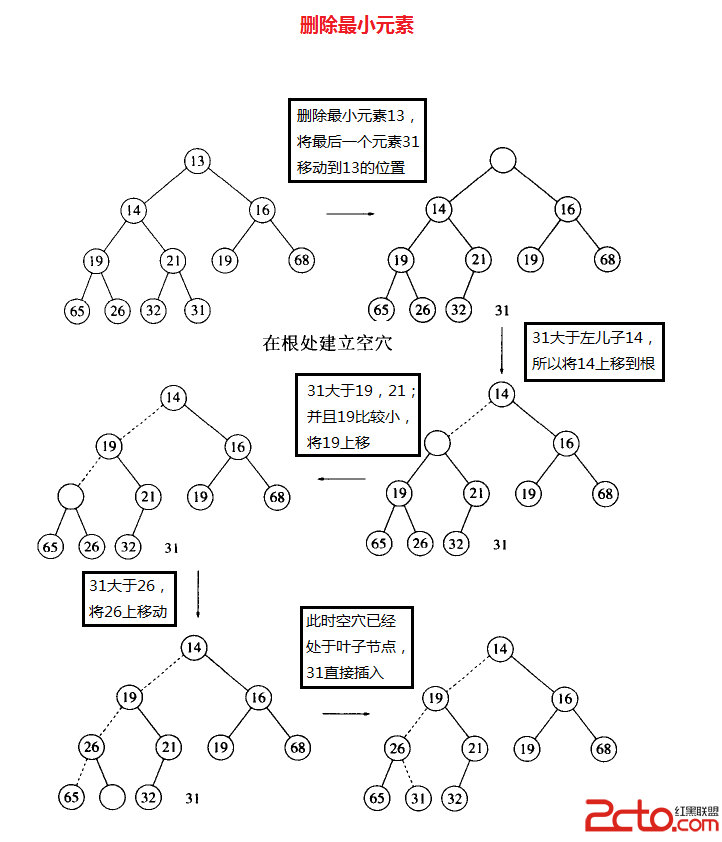操作系統表明上看著是支持多個應用程序同時運行,事實上是每個時刻只能有一個進程運行,操作系統會調度不同的進程去運行。每個進程都只能運行一個固定的時間,當超過了該時間,操作系統就會暫停當前運行的進程,去調度其它進程來執行。
實現這種進程調度的一種方法是使用隊列。開始的時候進程被放在隊列的末尾,調度程序將反復提取隊列中的第一個進程來執行,直到運行完畢或時間片用完,若進程沒有運行完畢則將該進程放入隊列的末尾。這種策略不是特別合適,因為可能一些短的進程需要等待很長的時間才能輪流到。一般來說,運行時間短的進程需要盡快的結束。所以那些運行時間短的進程需要比較高的優先權,同樣,那些比較重要的進程也需要比較高的優先權。
這種特殊的應用需要一種特殊的隊列-----優先隊列。可以用二叉堆實現優先隊列。
二叉堆與二叉查找樹類似,二叉樹有兩個性質:結構性質和堆序性質。
下面是一棵完全二叉樹的數組實現圖示:

vectorarray;//存儲二叉堆的節點 int currentSize;//當前二叉堆中的節點數目
bool isEmpty() const;//判斷二叉堆是否為空 const Comparable & findMin() const;//查找最小元素 void insert(const Comparable & x);//插入元素x void deleteMin();//刪除最小元素 void deleteMin(Comparable & minItem);//刪除最小元素,並以引用的方式返回該最小元素 void makeEmpty();//清空該二叉堆 void print() const;//打印該堆元素 void buildHeap();//將元素移動到合適的位置 void percolateDown(int hole);//下移動

/**************************************************************** * 函數名稱:insert(const Comparable & x) * 功能描述: 刪除最小元素 * 參數列表: 無 * 返回結果:void *****************************************************************/ templatevoid BinaryHeap ::insert(const Comparable & x) { if(currentSize == array.size()-1) array.resize(2 * array.size());//擴大堆中數組的容量 //獲得空穴的位置 int hole = ++currentSize; //上濾 for(; hole > 1 && x < array[hole/2]; hole /= 2) array[hole] = array[hole/2]; //將x插入到合適的位置 array[hole] = x; }
比如:在下圖中刪除最小元素的操作。
刪除最小元素13,將最後一個元素31移動到13的位置;31比13的兩個孩子的值都大,所有將兩個孩子值比較小的上移動。所以將14上移動。然後31再和14的兩個孩子的值比較,直到31比空穴的兩個孩子的值都小,或者是空穴到了葉子節點,則直接將31插入到空穴。

/**************************************************************** * 函數名稱:deleteMin() * 功能描述: 刪除最小元素 * 參數列表: 無 * 返回結果:void *****************************************************************/ templatevoid BinaryHeap ::deleteMin() { if(isEmpty()){ cout << "BinaryHeap is empty." << endl; return; } array[1] = array[currentSize];//將最後一個元素移動到最小元素的位置 currentSize--;//元素總數減去1 //將最後一個元素移動到合適的位置 percolateDown(1); } /**************************************************************** * 函數名稱:percolateDown(int hole) * 功能描述: 將array(hole)處的值向下移動 * 參數列表: hole為堆中元素的位置標號 * 返回結果:void *****************************************************************/ template void BinaryHeap ::percolateDown(int hole) { int child; //先保存array[hole]的值 Comparable temp = array[hole]; for(; hole * 2 <= currentSize; hole = child){ child = hole * 2; //child != currentSize,表明此時空穴有右兒子 //array[child] > array[child+1] 表明此時空穴有右兒子小於左兒子 if(child != currentSize && array[child] > array[child+1]) child++;//此時child表示為空穴的右兒子 //空穴的右兒子小於array[hole] if(array[child] < temp) array[hole] = array[child]; else break; } array[hole] = temp; }
//測試主函數
int main()
{
srand(unsigned(time(0)));
BinaryHeap binaryHeap;
vector v;
for(int i = 0; i < 10; ++i)
v.push_back(rand() % 10);
cout << "v: ";
for(int i = 0; i < 10; ++i)
cout << v[i] << " ";
cout << endl;
for(int i = 0; i < 10; ++i)
binaryHeap.insert(v[i]);
binaryHeap.print();
for(int i = 0; i < 12; i++){
int minVal = 0;
binaryHeap.deleteMin(minVal);
cout << "刪除最小元素:" << minVal << endl;
binaryHeap.print();
}
cout << "*****************************************" << endl;
cout << "測試第二個構造函數: " << endl;
BinaryHeap binaryHeap2(v);
binaryHeap2.print();
for(int i = 0; i < 12; i++){
int minVal = 0;
binaryHeap2.deleteMin(minVal);
cout << "刪除最小元素:" << minVal << endl;
binaryHeap2.print();
}
return 0;
}
/************************************************************************* > File Name: binaryHeap.cpp > Author: > Mail: > Created Time: 2016年04月14日 星期四 11時37分43秒 ************************************************************************/ #include#include #include #include using namespace std; /****************************************** * 類的名稱:二叉堆 ******************************************/ template class BinaryHeap { public: explicit BinaryHeap(int capacity = 100):array(capacity), currentSize(0){} explicit BinaryHeap(const vector & items); bool isEmpty() const;//判斷二叉堆是否為空 const Comparable & findMin() const;//查找最小元素 void insert(const Comparable & x);//插入元素x void deleteMin();//刪除最小元素 void deleteMin(Comparable & minItem);//刪除最小元素,並以引用的方式返回該最小元素 void makeEmpty();//清空該二叉堆 void print() const;//打印該堆元素 private: vector array;//存儲二叉堆的節點 int currentSize;//當前二叉堆中的節點數目 private: void buildHeap();//將元素移動到合適的位置 void percolateDown(int hole);//下移動 }; /**************************************************************** * 函數名稱:print() const * 功能描述: 打印該堆元素 * 參數列表: 無 * 返回結果:無 *****************************************************************/ template void BinaryHeap ::print() const { cout << "二叉堆的元素: " << endl; for(int i = 1; i <= currentSize; ++i) cout << array[i] << " "; cout << endl; } /**************************************************************** * 函數名稱:BinaryHeap(const vector & items) * 功能描述: 構造函數 * 參數列表: items 是構造二叉堆需要的數據 * 返回結果:無 *****************************************************************/ template BinaryHeap ::BinaryHeap(const vector & items):array(items.size()+10), currentSize(items.size()) { for(unsigned i = 0; i < items.size(); ++i) array[i+1] = items[i]; buildHeap(); } /**************************************************************** * 函數名稱:buildHeap() * 功能描述: 將元素移動到合適的位置,滿足堆序 * 參數列表: 無 * 返回結果:void *****************************************************************/ template void BinaryHeap ::buildHeap() { for(int i = currentSize / 2; i > 0; --i) percolateDown(i); } /**************************************************************** * 函數名稱:findMin() * 功能描述: 查找最小元素 * 參數列表: 無 * 返回結果:返回最小元素的引用 *****************************************************************/ template const Comparable & BinaryHeap ::findMin() const { return array[1]; } /**************************************************************** * 函數名稱:insert(const Comparable & x) * 功能描述: 刪除最小元素 * 參數列表: 無 * 返回結果:void *****************************************************************/ template void BinaryHeap ::insert(const Comparable & x) { if(currentSize == array.size()-1) array.resize(2 * array.size());//擴大堆中數組的容量 //獲得空穴的位置 int hole = ++currentSize; //上濾 for(; hole > 1 && x < array[hole/2]; hole /= 2) array[hole] = array[hole/2]; //將x插入到合適的位置 array[hole] = x; } /**************************************************************** * 函數名稱:deleteMin() * 功能描述: 刪除最小元素 * 參數列表: 無 * 返回結果:void *****************************************************************/ template void BinaryHeap ::deleteMin() { if(isEmpty()){ cout << "BinaryHeap is empty." << endl; return; } array[1] = array[currentSize];//將最後一個元素移動到最小元素的位置 currentSize--;//元素總數減去1 //將最後一個元素移動到合適的位置 percolateDown(1); } /**************************************************************** * 函數名稱:percolateDown(int hole) * 功能描述: 將array(hole)處的值向下移動 * 參數列表: hole為堆中元素的位置標號 * 返回結果:void *****************************************************************/ template void BinaryHeap ::percolateDown(int hole) { int child; //先保存array[hole]的值 Comparable temp = array[hole]; for(; hole * 2 <= currentSize; hole = child){ child = hole * 2; //child != currentSize,表明此時空穴有右兒子 //array[child] > array[child+1] 表明此時空穴有右兒子小於左兒子 if(child != currentSize && array[child] > array[child+1]) child++;//此時child表示為空穴的右兒子 //空穴的右兒子小於array[hole] if(array[child] < temp) array[hole] = array[child]; else break; } array[hole] = temp; } /**************************************************************** * 函數名稱:deleteMin(Comparable & minItem) * 功能描述: 刪除最小元素 * 參數列表: minItem 將最小元素賦值給引用minItem * 返回結果:void *****************************************************************/ template void BinaryHeap ::deleteMin(Comparable & minItem) { if(isEmpty()){ cout << "binaryHeap is empty." << endl; return; } minItem = array[1]; array[1] = array[currentSize--]; percolateDown(1); } /**************************************************************** * 函數名稱:makeEmpty() * 功能描述: 情況二叉堆 * 參數列表: 無 * 返回結果:void *****************************************************************/ template void BinaryHeap ::makeEmpty() { currentSize = 0; } /**************************************************************** * 函數名稱:isEmpty() * 功能描述: 判斷二叉堆是否為空 * 參數列表: 無 * 返回結果:如果為空,則返回true,否則返回false *****************************************************************/ template bool BinaryHeap ::isEmpty() const { return currentSize == 0; } //測試主函數 int main() { srand(unsigned(time(0))); BinaryHeap binaryHeap; vector v; for(int i = 0; i < 10; ++i) v.push_back(rand() % 10); cout << "v: "; for(int i = 0; i < 10; ++i) cout << v[i] << " "; cout << endl; for(int i = 0; i < 10; ++i) binaryHeap.insert(v[i]); binaryHeap.print(); for(int i = 0; i < 12; i++){ int minVal = 0; binaryHeap.deleteMin(minVal); cout << "刪除最小元素:" << minVal << endl; binaryHeap.print(); } cout << "*****************************************" << endl; cout << "測試第二個構造函數: " << endl; BinaryHeap binaryHeap2(v); binaryHeap2.print(); for(int i = 0; i < 12; i++){ int minVal = 0; binaryHeap2.deleteMin(minVal); cout << "刪除最小元素:" << minVal << endl; binaryHeap2.print(); } return 0; }
v: 5 3 8 4 3 6 1 5 4 5 二叉堆的元素: 1 3 3 4 4 8 6 5 5 5 刪除最小元素:1 二叉堆的元素: 3 4 3 5 4 8 6 5 5 刪除最小元素:3 二叉堆的元素: 3 4 5 5 4 8 6 5 刪除最小元素:3 二叉堆的元素: 4 4 5 5 5 8 6 刪除最小元素:4 二叉堆的元素: 4 5 5 6 5 8 刪除最小元素:4 二叉堆的元素: 5 5 5 6 8 刪除最小元素:5 二叉堆的元素: 5 6 5 8 刪除最小元素:5 二叉堆的元素: 5 6 8 刪除最小元素:5 二叉堆的元素: 6 8 刪除最小元素:6 二叉堆的元素: 8 刪除最小元素:8 二叉堆的元素: binaryHeap is empty. 刪除最小元素:0 二叉堆的元素: binaryHeap is empty. 刪除最小元素:0 二叉堆的元素: ***************************************** 測試第二個構造函數: 二叉堆的元素: 1 3 5 4 3 6 8 5 4 5 刪除最小元素:1 二叉堆的元素: 3 3 5 4 5 6 8 5 4 刪除最小元素:3 二叉堆的元素: 3 4 5 4 5 6 8 5 刪除最小元素:3 二叉堆的元素: 4 4 5 5 5 6 8 刪除最小元素:4 二叉堆的元素: 4 5 5 8 5 6 刪除最小元素:4 二叉堆的元素: 5 5 5 8 6 刪除最小元素:5 二叉堆的元素: 5 6 5 8 刪除最小元素:5 二叉堆的元素: 5 6 8 刪除最小元素:5 二叉堆的元素: 6 8 刪除最小元素:6 二叉堆的元素: 8 刪除最小元素:8 二叉堆的元素: binaryHeap is empty. 刪除最小元素:0 二叉堆的元素: binaryHeap is empty. 刪除最小元素:0 二叉堆的元素: